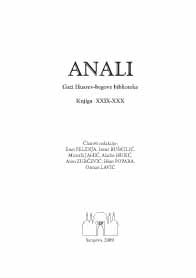TRI NEOBJAVLJENA DOKUMENTA O BANJALUČKOM MUTESELLIMU I MUHAFIZU ALI-BEGU GROŠIĆU - PRILOG HISTORIJI BANJE LUKE 1738-1740.
Three unpublished documents about Banjaluka’s Mutesellim and Muhafiz Ali-bey Grošić - contribution to the history of Banja Luka 1738-1740
Author(s): Haso PoparaSubject(s): History
Published by: Gazi Husrev-begova biblioteka
Keywords: Ali-beg Grošić; Banja Luka; mutesellim; muhafiz; dizdar; aga; Hekim-oglu; Ali-paša; Dur-Ali; Abdulmennan; Musa; kadija; defter; popis; ostavina; nasljednici.
Summary/Abstract: In the collection of Turkish documents which were donated two years ago to the Gazi Husrev-bey Library in Sarajevo, from the family Đumišić from Banja Luka, there are three documents related to Ali-bey Grošić. To our scholarly population up to now, it was only known that Ali-bey Grošić was a representative (mutesellim) from Banja Luka, who was killed on duty in 1740; that his killers ran away and that in permission (murasela) of mufti od Banja Luka (4. džumade-l-evvel 1153 / 28. july 1470) he was asked from the imam of mahala where family of the killers lived to be captured and expelled and their houses burned and destroyed. From these three unpublished documents, it is visible that Ali-bey’s father was Dur-Ali, son of Abdulmenna, which refers to his Christian origin. In the first document (defter) which was written on 27. rebiu-levvel 1151 /16. july 1737 by qadi of Banja Luka, Mehmed, in order (buyuruldi) of Bosnian governor of a province (vali) Hekim-ogly Gazi Ali-pasha, is mentioned accomodation and 1.000 sheep, 100 cattle and 150 šinika of barley for the need of tatars solders who fight against enemy. In the second document which was written by the same qadi on13 rebiu-l-evvel /16 july 1737, on directive of Hekim-ogly Gazi Ali-pasha, talks about acquisition of 300 cattle, 2.000 sheep and enough bread and hard biscuit (peksimet) and different pasta for needs of solders. Both of these documents were handed to Ali-bey Grošić to carry out executions, since he was in that time on duty of commander of fortress (muhafiz) of Banja Luka. Since all this was happening within one year from the battle of Banja Luka in 1737, one could predict that Ali-bey Grošić was directly participated or involved in that battle. In the third document which was made by qadi Musa (same qadi who directed the already mentioned murasela) on 8 sefar 1153 /5 may 1740, and whose complete translation are given in Bosnian language, talks about distribution of his inheritance among Ali-bey successors: wife Meve Kadun, daughter of Mustafa and Hatidža, daughter Murtezine, underage son Omer, adult doughters: Aiša, Umi Kulsum, Merjem and Hatidža and underage daughter Emina. From this document it could be seen that Ali-bey Grošić, apart from being mutesellim and muhafiz of Banja Luka, was also a military commander (dizdar and aga). In this document as his employee are mentioined: Ibrahim-aga, capetein of Gradiška, the second Ibrahim, commander (aga) of unit – detachment đonlija and capetein of Banja Luka, Husejin, aga of unit đonlija, Omer Fejzi-zade (Fejzić), janitor in a large establishment (odobaša), Mustafa, odobaša, Murat-aga, old dizdar, Daud, aga the first unit of faris, Šašakin Ibrahim-basha, Abdullah, aga martoloza, and as his people of the trust is mentioned: Husejin, odobaša, Derviš-bey, artilleryman, Ibrahimaga, artilleryman, Husein odobaša.
Journal: Anali Gazi Husrev-begove biblioteke
- Issue Year: 2009
- Issue No: 29-30
- Page Range: 5-40
- Page Count: 36
- Language: Bosnian

